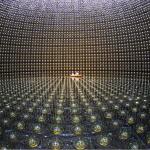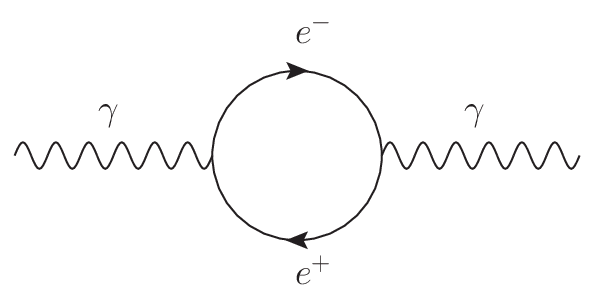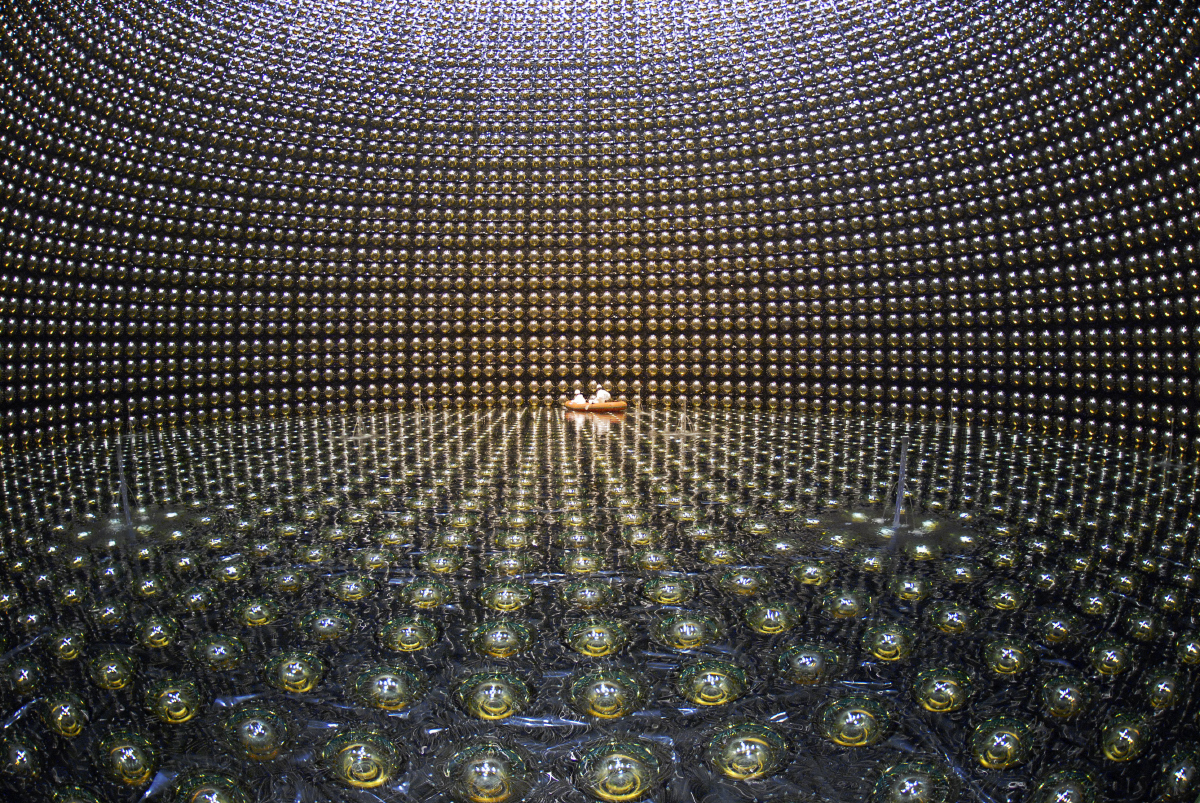Physicists showing some GUTs: unification in physics

October 4, 2023 by lucamarsili
For Aristotle, the origin of all matter and all the physical phenomena on Earth could be explained by the different behavior of only four elements: earth, air, fire, and water.
For Platon, the understanding of the Universe could be understood only through the pure essence of geometry, and everything could be explained in terms of it.
In a nutshell, one can describe this procedure as the unification of seemingly unrelated concepts into different manifestations of the same phenomenon.
This has been the main approach of physicists from all the epochs.
From Newton to the Standard Model
Until the first scientific revolution, it has always been thought that the laws of Nature on Earth and the laws of the Universe were completely different and that what was happening on Earth wasn’t following the same rules as what was happening in the Sky.
With his theory of gravity, Newton proved that the laws of attraction between two planets and what makes an apple fall share the same origin: gravity.
Newton unified for the first time two completely distant worlds, Space and Earth.
In the next centuries, physics improved and in the nineteenth century, many physicists were studying again the behavior of apparently two different forces, electricity and magnetism.
James Maxwell found that these two forces actually originated from the same field, and it was called electromagnetism.
Indeed, what can be interpreted as an electric field for an observer, for an observer moving at a different velocity could appear as a magnetic field and vice versa!
If this makes you think about the theory of relativity, you are right! But this is another long story!
If it doesn’t, don’t worry, but it could be interesting to know that the formulation of electromagnetism and its inconsistency with the laws of mechanics pushed Einstein to conceive the theory of special relativity.
Every successful attempt to unify concepts in physics has heavily boosted and revolutionized the field and in general the human comprehension of the world. These discoveries are associated also with completely new phenomena, such as electromagnetic waves, which we use almost for everything and they would never be understood without the attempt to unify different forces from Maxwell.
After the developments in the last centuries, physicists agree that there are 4 fundamental interactions: gravity, strong, weak, and electromagnetic force.
Gravity is the weakest one and probably the most famous. Despite that, it is also the most complicated one to study since its formulation is not consistent with quantum mechanics.
Luckily, due to its weakness, one cannot consider gravity when studying particle physics.
While we have already discussed a bit about electromagnetism, strong and weak interactions, instead, may sound a bit exotic but they are worth an explanation.
Both of them come from nuclear physics, the strong interaction keeps together the protons and the neutrons inside the nucleus, while the weak interaction makes this nuclei decay in lighter nuclei.
In other words, weak interaction is one of the responsible of radioactivity.
Again, we are in a situation in which these forces seem completely distant from each other and one could ask: how on Earth does my Wifi connection share the same origin of what keeps together protons and neutrons in a nucleus?!
The Quest for Grand Unification
Everything started in the ‘60s and physicists, once the tools that we are still using today to study particle physics were comprehended, started to try to apply them to study the behavior of these forces at a more fundamental level.
It turned out that one could model an interaction using symmetry, and that different symmetries correspond to different kinds of interactions.
Let's start with one of the first attempts made to understand the interaction between protons and neutrons.
The simple idea is that these two particles look approximately the same and, if one does not look at the electromagnetic interaction, these two particles could interact identically under a kind of nuclear interaction (a first attempt to understand the strong force).
Therefore, if one changes these two particles nothing should happen. So this nuclear force is associated with a certain symmetry, which mathematically corresponds to a group: in such case, it is called SU(2). This wasn’t the whole story but the approach turned out to be good.
Indeed, protons and neutrons are made up of quarks, and they interact via strong interactions. The quarks can be grouped into three colors, but the strong interaction is blind to color, and therefore, one can change color without any changes. The theory that describes such interactions is called Quantum Chromodynamics.
The symmetry behind this is called SU(3).
At the same time, people tried to do that with electromagnetism and the weak force, and since the strength of the two interactions was similar, people tried to describe both of them within only one generic symmetry. This is the modern way of unifying forces, finding a unifying symmetry that can explain all the interactions.
Weinberg, Glashow, and Salam found that, indeed, at high energy, there are no separate weak and electromagnetic interactions, but they can be described simultaneously by a symmetry called SU(2) X U(1).
But, differently from SU(3), this is not what we observe in ordinary life, but only in big colliders.
This happens because at low energy, the symmetry is broken and the only surviving interaction is the electromagnetic interaction.
So, the situation while I am writing is this one: if we don’t consider gravity we have two different interactions at high energies: electroweak and strong interactions.
What would you do now? First Earth and Space, then magnetism and electricity, and finally weak interaction and electromagnetism turned out to be unified, too.
What is the next step?
Of course, physicists started to look for symmetries that could explain strong and electroweak interactions, but there is a deeper reason why physicists started looking for Grand Unified Theories, or GUTs.
But first, we need to go one step behind and look at one of the most amazing features of the framework we are using to describe fundamental physics: quantum field theory.
A quick detour on quantum field theory
Soon after the development of quantum mechanics, physicists started right after to try unifying quantum mechanics and special relativity.
But, looking at the dates of the published work in these two topics, we can see that the time difference between the major works on quantum mechanics and its relativistic extension, quantum field theory, is more or less 30 years! Why did it take so long?
Because of infinities.
Indeed, the first works on quantum field theories were published at the beginning of the ‘30s but they soon started noticing that, as soon as you want to consider quantum effects while computing some physical processes, infinities appear everywhere and this framework was believed to be inconsistent and it was abandoned.
Then, renormalization arrived and revolutionized the field.
The solution to this problem is that such a framework is not made for computing absolute quantities, and in fact, in physics, it is only possible to compute physical observables in terms of other physical observables.
There is no absolute in physics.
After realizing that, different methods to cancel these infinities were introduced.
Finally, physicists were able to make predictions using this formalism and quantum field theory is still the main framework used to compute all the scattering rates observed at LHC at CERN, and many other things.
One of the quantum effects that needed to be renormalized, is called vacuum polarization.
Let’s imagine a simple process, such as two electrons scattering with each other. At a fundamental level what makes them interact is an exchange of a virtual particle between the electrons. When speaking about electromagnetic interaction this particle is called a photon.
What this abstract and difficult-to-understand exchange of particles causes, is that these two electrons repulse each other and scatter.
But if one wants to be precise and compute the outcome of this process with more accuracy, this simple exchange of photons is not enough. This is because this photon can originate an electron-antielectron pair, which then annihilates into a photon again. While propagating, this photon can do that many times and it can do even much more complicated stuff (Fig. 1).

Fig. 1. The Feynman diagram of the vacuum polarization: this draw represent a complicated integral which has to be renormalized.
Due to the infamous uncertainty principle of quantum mechanics, is not possible to measure precisely the position and momentum of a particle. When you deal with fields, this translates into the fact that you cannot know exactly the energy of the field in an exact instant of time. Therefore, there can be quantum fluctuations of energy that are interpreted as particle-antiparticle pairs generating from the vacuum and then annihilating again.
So even when nothing happens, something always happens in quantum field theory!
A consequence of vacuum polarization is that we cannot know exactly what is the charge of a particle in an absolute sense. If you study simple electromagnetism you will have to deal with forces, and charges, and everything seems fixed and static.
The electron has a definite charge, and for example, you need to compute the force of attraction between an electron and another charged object.
In fact, even the charge of the electron is not fixed but depends on the energy at which is measured: everything is much more complicated!
To understand this we need to start again from the basic principles of quantum mechanics and we need to picture a fundamental particle such as the electron, as a wave.
In quantum mechanics, the higher the frequency of a wave, the higher its energy. But a short frequency means a short wavelength, and therefore increasing its resolution.
Now, finally, we can picture a simple electron as surrounded by electron-antielectron pairs, which, due to its charge, are polarized and shield the electron’s electromagnetic field. An external probe at a distance would measure a lower electric charge then, but as the probe gains energy its wavelength decreases and you can pass through the shield, detecting a higher electric charge at higher energies.
We say that the couplings (in this case, the electric charge) run and different kinds of interaction predict different kinds of runnings.
For example, quarks interact under the strong interaction, and their charge behaves differently: it becomes weaker as the quarks gain energy. Indeed, the quarks look like free particles at high energies, while they are so tightly bound at low energies that we cannot observe a single quark, but only bound states.
This is not the end of the story.
The Quest for Grand Unification: Part II
Within the framework of the Standard Model, you can precisely compute how the three interactions of the Standard Model change with energy.
It seems that these three couplings run towards the same value, and they almost match.
More surprisingly, if you modify slightly the Standard Model symmetries, it turns out that these couplings actually match toward a single value at high energies.
This is absolutely non-trivial and there are two possible explanations for this astonishing fact:
• This is just a coincidence
• There is only a single fundamental interaction, and only at low energies do weak, electromagnetic, and strong interactions behave differently.
The second possibility sounds more optimistic and could be a very fruitful approach. So, right after the development of the Standard Model, physicists jumped into this problem and developed many possible models of Grand Unified Theories. Some examples that could sound very exotic to you are SUSY SU(5), Flipped SU(5), SO(10), E6, …
The journey started in the 60’s and it is still on and now we can ask the final question.
How we can test this crazy idea?!
Testing GUT
Having a single fundamental force means that all the particle interacts in the same way concerning that force, and this fact opens a new selection of possible kind of physical processes.
In particular, the up and down quarks inside the proton could produce a down quark and a positron.
In such a case, the proton would decay into a pion (a composite particle made by a quark and an antiquark) and a positron. Similarly, the proton could decay into a kaon (another particle made by quarks) and a neutrino.
In summary, the proton, which otherwise would be a stable particle, is predicted to decay!
This is the main experimental prediction of such a theory, but since the energies at which this Grand Unification of the couplings happens are very high, this process, if it happens, happens very slowly.
In general, the rate of the interaction depends on the mass of the particle that carries the interaction: the heavier the mass the slower the rate of the process.
The unification is usually reached at very high energy, and therefore the mass of this carrying interaction is high as well: the lifetime of the proton is indeed around 10^35 years!
That is 1000000000000000000000000000000000 years!
To make a comparison the age of the Universe is only around 15000000000 years, a 25-order-of-magnitude difference.
To make a comparison, it takes approximately 10^-5 years to read this article: the difference between this time and the age of the Universe is 10 orders of magnitude less than the difference between the age of the Universe and the average lifetime of the proton if it actually decays.
This process may sound impossible to detect, but instead with amazing technologies physicists can test this incredibly rare process.
To detect it, since the lifetime is so high, you need a lot of protons, and a lot of time.
In the ‘70 people started to build big tanks of water: water contains hydrogen atoms which are basically protons, and within a decade of nonobservation, one can arrive to constrain the proton lifetime up to approximately 10^34 years.
If the proton decays, as we mentioned before, it could decay into a pion (a particle made of quarks) and a positron.
The pion subsequently decays into two photons and the positron would annihilate into an electron and generate another photon. This particular signature would be the smoking gun of such a process.
Since the lifetime is proportional to the mass scale of the gauge boson, we can constrain the mass of this heavy particle and the scale at which this unification is reached.
If you want to further constrain the lifetime, you need even more protons and therefore even bigger tanks of water. First, was Kamiokande, then Super-Kamiokande which provides the best current bound on this process.
This is a 41-meter-high tank with a diameter of around 40 meters, built in a mine in Japan. This shields the detectors from background processes.
In the next decade, Hyper-Kamiokande even bigger than Super-K, DUNE, and JUNO (which work differently and are sensible to a different kind of decay), will improve this constraint hoping to achieve what could be a historical discovery.

Fig. 2: The inside of SuperKamiokande: a tank higher more than 40m in which physicist try to detect proton decay. Credit: Kamioka Observatory, ICRR (Institute for Cosmic Ray Research), The University of Tokyo.
The search for new physics continue
From ancient history to these days, the aim toward unification has pushed forward the comprehension of the physical world and it is still a promising candidate for what is called New Physics or Physics Beyond the Standard Model. Many models of Grand Unified Theories can achieve outstanding results such as providing models of dark matter, explaining the matter-antimatter asymmetry in the Universe, or predicting the mass of the known particles.
Anyway, this is only a possible direction among many interesting other where to look for new physics. In the next decades, many experiments will be launched, from neutrino physics to gravitational waves that hopefully will shed light on this extension of the Standard Model, but that’s another story!
-
The main purpose of Kamiokande...
... was the detection of proton decay, incidentally has provided important information on neutrino oscillation and th...


